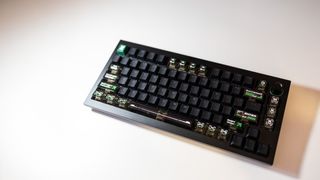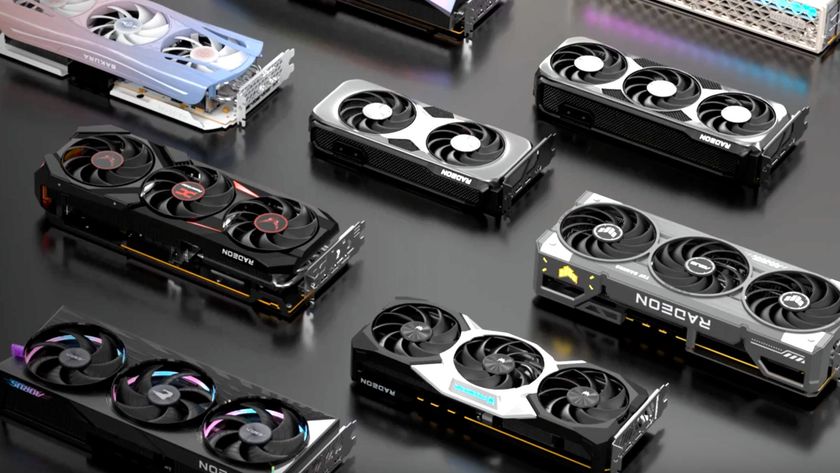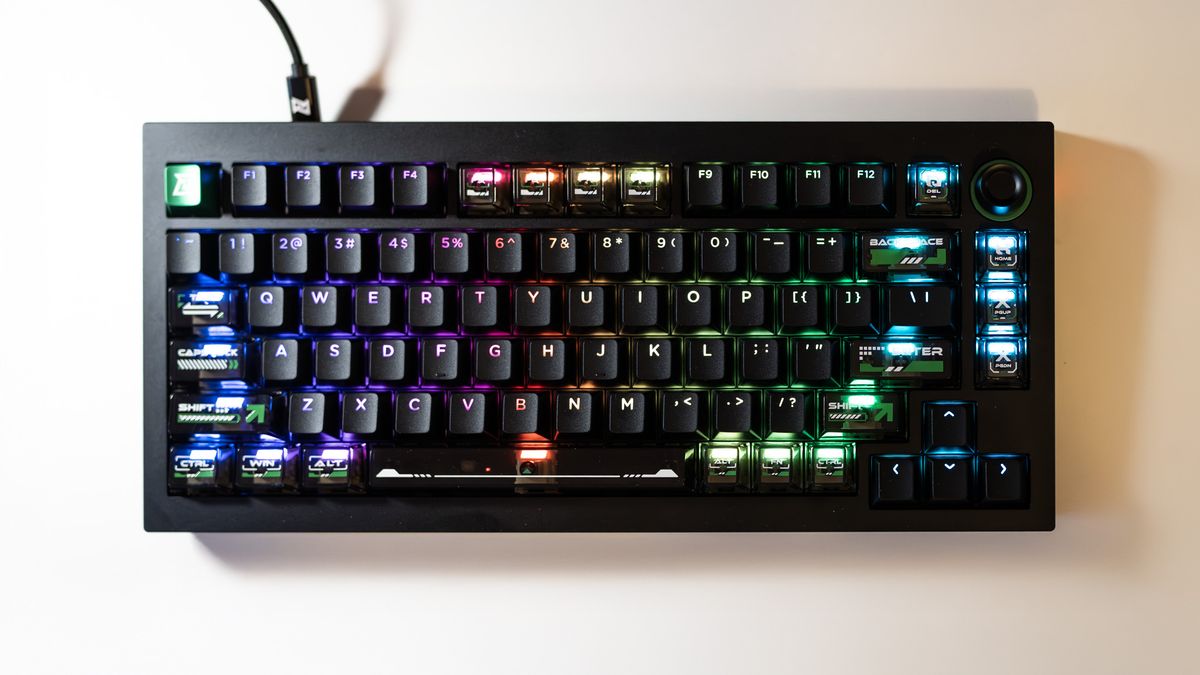Our Verdict
As an advertisement for what Hall effect switches can do, the Lemokey L5 HE 8K is a good one. Happily, it’s also an excellent keyboard in itself, and capable of making a glorious racket.
For
- Extremely smooth action
- Sturdy build
- Excellent noise
Against
- Not wireless
- Could do with some instructions
- Does it need to be this heavy?
PC Gamer's got your back
Far be it for me to bore you with physics, but the Hall effect—the production of a potential difference across an electrical conductor that is transverse to an electric current in the conductor and to an applied magnetic field perpendicular to the current, as you well know—is brilliant. At least, it is when it’s applied to keyboards and game controllers, as it allows them to use something quite like a motion sensor that works over a tiny distance instead of a microswitch or bits of metal and plastic sliding over one another. This means keyboard switches with quicker response times and less grinding of plastic parts against other bits, so your switches wear out less easily.
All of which sounds great, and PC Gamer has long been a sucker for anything that seems like it might speed up keypresses. It’s also not new, and we’ve seen boards from the likes of SteelSeries, NuPhy and more—many of the best gaming keyboards, in fact—apply the Hall effect, and do it really well.
The Lemokey L5 HE 8K keyboard is the subject of a Kickstarter campaign, and Lemokey is a fork of Keychron whose keyboards have traditionally reviewed well. Indeed, the L5 HE isn’t too dissimilar to the Keychron Q3 Max—at least outwardly.
What Lemokey has provided is a 75%-size rapid trigger gaming keyboard with an 8,000 Hz polling and scan rate, Hall effect switches, and 0.01 mm sensitivity. It’s also, as you notice the instant you get it out of the packaging, extremely heavy. Sharpen this keyboard (and it already has quite an edge at the back), stick it on a pole, and you’ll be wielding an effective weapon once society collapses.

Switch type: Hall effect
Keycaps: PBT
Lighting: RGB
Onboard storage: none
Ports: 1x USB-C
Connection type: Wired
Cable: USB Type-C/USB Type-A, detachable
Weight: 1.8 kg
Price: $199
But until then you’ll have around 1.8 kg of machined aluminium and plastic on your desk that’s quite resistant to being pushed around no matter how much you hammer away on it.
And it sounds amazing. The keyboard sent to the exclusive PC Gamer testing lab and Michelin Star restaurant for review is black and green, with some of the keys topped with transparent caps, and others with black. That’s fine, though black and red might be a more striking colour scheme and I hope they offer it, but the sound they make when pressed is phenomenal.
If you’re the sort of person who bottoms out the keys, you’ll get the distinctive double-click of the key going as far as it can before springing back up again—there's no case rattle from Lemokey’s heavyweight metal build, so it’s a pure noise from the keys themselves. If you’re more restrained and are able to hold back, releasing the key long before it makes contact and making the most of the keyboard’s ridiculously high activation point, then you’re still rewarded with a single pop. The sound as it reaches the top is more hollow than the click from the bottom, but the whole thing sounds gloriously old-fashioned, almost like a mechanical typewriter at times.


As a 75% keyboard things can get a bit cramped, and the keys themselves are slightly smaller than those you’d find on a membrane model. At least the arrow keys (there is no numpad) are decently sized, unlike on many laptops, and though the Enter key is cut down and topped by a massive key apparently dedicated to obscure punctuation of interest only to programmers, there are Home, PgUp and PgDn keys given their own little section on the right, while the opportunity has been taken to jettison the irksome Copilot key that’s been creeping in thanks to Microsoft’s AI shenanigans. The tops of the keys have a slightly rough texture that feels exactly like plastic, which is what they are. I’m all for honesty in vernacular keyboard architecture, but their hard tops and sharp edges can get a little tiring after heavy use, and something to disguise and soften them might help. But then this is a customisable keyboard, so there may be something out there that can do just that.
At the top right of the keyboard is a dial, and this is the sole disappointment on the board. You grasp it between thumb and forefinger purposefully, expecting a meaty chonk as it clicks around... and while there is a bit of resistance, the clicks are weaker than the general disposition of the board would suggest. It also, in the review model sent to us at any rate, had a bit of play and wobble that wasn’t present anywhere else. It’s probably going to be fine if you’re using it to adjust the volume while playing, but feels incongruous considering the quality on display elsewhere.



✅ You want a smooth switch: these Hall effect switches don’t click when they pass the activation point, so the key descends smoothly. Activation is almost instant, so you’ll never be left wondering if it worked.
❌ Your neighbours like the quiet life: bottom out the keys and you’ll produce a wonderful double-click as the keycap touches the frame and pops back up again. It sounds great, but could get a little annoying.
Likewise, the keyboard comes with two screwdrivers, a key removal tool, and some extra bits, as well as a switch on the back that I suspect adjusts polling rate, but there are no instructions about what anything does. Customisable keyboards are a fascinating facet of PC gaming, but someone coming to it for the first time would be left puzzled by the lack of direction here, and we hope it’s included with the finalised model sent out to backers.
And as for those Hall effect switches, they feel great. There’s none of the gritty catch as the switch activates—which may actually be a downside if you rely on that for feedback while playing—and there's just enough travel and resistance in the keys for a really good typing experience, though you may need some wrist support to get your hand into the ideal position thanks to the height the metal frame provides.
The L5 HE is a wired board, connected with a USB-C port and included cable (plus a C to A adapter), and comes with 22 RGB backlighting options controlled using Fn key combinations and the dial - though it’s also compatible with the Keychron web app to update firmware, create macro combos, toggle rapid trigger and more. And at $199, it’s also a touch expensive next to PCG’s favourite (and most wooden) Hall effect keyboard, the Keychron K2 HE, which goes for around $140. These details pale into insignificance beside the glory of the L5 HE’s keys and massive metal presence on the desktop, however. The problem now is finding a mouse that can offer the same sort of build quality and sit rightfully alongside it.
As an advertisement for what Hall effect switches can do, the Lemokey L5 HE 8K is a good one. Happily, it’s also an excellent keyboard in itself, and capable of making a glorious racket.

Ian Evenden has been doing this for far too long and should know better. The first issue of PC Gamer he read was probably issue 15, though it's a bit hazy, and there's nothing he doesn't know about tweaking interrupt requests for running Syndicate. He's worked for PC Format, Maximum PC, Edge, Creative Bloq, Gamesmaster, and anyone who'll have him. In his spare time he grows vegetables of prodigious size.

FF14 streamer yields to the MMO's bounciest catgirl, after inspiring them to beat his new speedrunning record 3 times before he could finish making a video about it

AMD's 'official' performance figures for RDNA 4 leak out early, with the RX 9070 XT claimed to be 42% faster than the RX 7900 GRE at 4K

After only 31 days, the breakout WarioWare-like game Mindwave has raised over $440,000 thanks to a brilliant demo, which you can still play now
